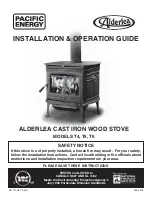
7
CAUTION! BEFORE CLEANING
C H I M N E Y AND SMOKE PIPE BE
SURE FIRE IS OUT AND INSIDE OF
STOVE IS COOL.
Cleaning The Chimney and Smoke
Pipe
Avoid chimney fires. On a regular
schedule, check for creosote and soot
buildup in the chimney, smoke pipe and
spiral chamber. They must be kept
clean. Keep a professional chimney
sweep in mind if you have access to
one.
Steel brushes are the safest for
cleaning metal surfaces. Salt solutions
and some chemicals may damage
metal surfaces. Do not overfire your
stove. Do not burn anything that com-
busts in seconds. Excessive flue tem-
peratures may result thereby igniting
creosote.
To clean the chimney, obtain a stiff
brush with an extendible handle and
insert the brush into the chimney from
the top. Continue the brushing and
sweeping downward until the entire
length of the chimney is cleaned.
After cleaning the chimney, the
debris will be at the bottom of the chim-
ney at the clean-out opening. Open the
clean-out door and sweep the debris
out into a metal container.
The smoke pipe from the stove to
the chimney can be cleaned with a
steel brush.
8. Operating
Instructions
8.1
Starting a Coal Fire
Take about eight sheets of news-
paper, crumble into balls and place on
top of grates. Next, lay fine kindling on
top of the paper. This kindling must be
dry and no larger than 3/4" in diameter.
Layer the kindling in a criss-cross fash-
ion to allow good air flow. Open the
draft control fully and light the paper
just inside the door. Now, close the
loading door and allow the kindling to
catch fire. After a few minutes, open the
loading door an inch or two for a few
seconds before opening completely.
This method will allow smoke to clear
away from the door opening before the
loading door is completely opened.
Add small, compact pieces of hard-
wood when the kindling is burning hot.
Keep the draft controls fully open to
establish a hot fire quickly. The ash
door also may be opened during start-
up to accelerate the initial burn.
When a substantial bed of red
wood coals are built up, start adding
coal (pea or nut is preferred to stove
coal for starting) small amounts at a
time. Keep the draft control open.
Continue adding small amounts of
coal until there is a solid bed of burning
coal. Do not add too much at one time.
Allow sufficient time between each
small loading (at least 5-10 minutes),
so that each loading has time to ignite
thoroughly before the next load is put
in. When a substantial bed of burning
coals has been established, fill the
stove to the top of the firebrick. A deep
bed of coal always will burn more satis-
factorily than a shallow bed.
When most of the wood is burned
and the coal is completely ignited (usu-
ally 5-10 minutes or less after filling the
stove), the draft control should be
turned down to the proper operating
level. (If the ash door has been opened,
it must be closed to prevent overfiring,
which can cause dangerously high
temperatures.)
8.2
Loading
Coal should never be added unless
there is a reasonable hot fire. The coal
bed should be bright and vigorous.
If the fire is burning hot and there is
a deep bed of coals, full loads of coal
can be added at any time. However, if
there is not a deep bed of coals, it is
best to add small amounts of coal at
first.
8.3
Increasing Heat From a
Low Fire
Every effort should be made not to
let a coal fire burn too long so that the
fire has started to die. This will cause
the reloading process to be much
longer, and there is a good possibility of
losing the fire.
Do not shake or stir with a low fire.
Open the draft control wide or open
the ash cleanout door to get the maxi-
mum draft.
Run the stove with the draft control
or ash door fully open until the fire is
reasonably hot.
Start adding small amounts of coal.
When the new coal is thoroughly ignit-
ed or there is a substantial bed of hot
coals, the stove may be shaken thor-
oughly. Be sure to shake down all
ashes (but do not overshake).
After shaking, keep the bottom
draft control open until you are sure the
fire is continuing to burn hot, then turn
the draft control down to the proper
operating level. IF THE ASH DOOR
HAS BEEN OPENED, BE SURE TO
SHUT IT (SERIOUS DAMAGE CAN
RESULT IF THE STOVE IS RUN FOR
EXTENDED PERIODS WITH T H E
ASH DOOR OPEN).
Count the exact number of turns
from full shut to the normal operating
positions so that you can adjust the
stove to the exact level of heat output
and length of burn you desire.
Figure 7
Содержание I
Страница 14: ......
Страница 15: ...MIP 9331 Rev 07 04 ...

































